- Introduction
- Understanding Drum Stick Sizes: A Deep Dive
- The Impact of Drum Stick Sizes on Performance
- Drum Stick Sizes and Weights: Finding Your Perfect Match
- How drum sticks affect size perception.
- Choosing the Right Drum Stick: A Guide for Every Drummer.
- Conclusion: Embrace the Journey to Find Your Perfect Stick
- FAQ:
Introduction
Does size matter when it comes to drum sticks? Some may argue that technique is the key, but the truth is, the size of your drumsticks can make or break your performance . The right size isn’t just about comfort; it’s about control, sound, and style. Whether you’re playing jazz or keeping it smooth, the perfect stick is out there at the end. Every drummer wants sticks that feel right and sound great. It’s time to find yours.
Understanding Drum Stick Sizes: A Deep Dive
When you’re drumming, the size of your drum stick is more than just a number or letter—it’s your key to getting the perfect sound and feel. Let’s break down what those numbers and letters on your drum sticks mean and how they can influence your playing style.
What Do the Numbers on Drum Sticks Mean?
The numbers on drum sticks, such as 5A, 7A, or 2B, may seem confusing at first, but once you get the hang of it, they’re quite straightforward. These measurements primarily indicate the thickness and sometimes the length of the stick. Generally, the lower the number, the thicker the stick. For instance, a 2B stick is thicker than a 5A stick. This thickness directly affects the weight and feel of the stick in your hand, as well as the power and volume you can produce on your drums.
- 5A: This option is considered the middle ground, offering versatility across various music genres.
- 7A: Light and thin, ideal for jazz and acoustic sessions where finesse is crucial.
- 2B: Thicker and heavier, best suited for rock and heavy metal, where loud, powerful beats are required.
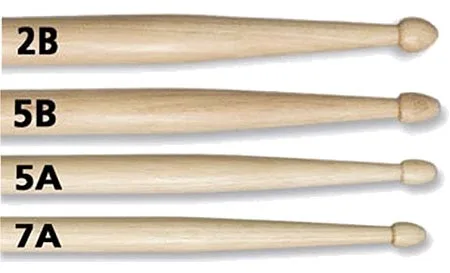
Decoding Letters on Drum Sticks
The letters, on the other hand, provide insight into the intended use of the stick. Here’s a brief overview:
- A (Orchestra): Suitable for a wide range of music, offering balance and versatility.
- B (Band): Provides a bit more weight, making them ideal for band and ensemble playing.
- S (Street): These sticks are designed for marching bands and are durable and designed for projection.
Drum Stick Sizes Chart: Understanding Their Meanings
Visualize a chart with drum stick sizes lined up from the thinnest to the thickest. At one end, you have the 7A, a slender stick that feels almost weightless in your hand, perfect for light, fast playing. Move towards the middle and you find the 5A, a jack-of-all-trades that provides balance and agility. On the other hand, the 2B looms large, its weight promising power and volume.
Personal Experience: Finding the Right Fit
When I started drumming, I was given a pair of 5A sticks. They felt good, but I only really understood the impact of size after experimenting with 7A and 2B sticks. The 7A sticks let me play faster, more intricate rhythms, while the 2B sticks made my rock beats more powerful than ever. It was a revelation, showing me that there’s no one-size-fits-all when it comes to drum sticks.
The Impact of Drum Stick Sizes on Performance
Understanding how drum stick sizes affect your playability and sound is crucial for any drummer, from a garage band enthusiast to a professional touring artist. Let’s delve into the performance implications of different sizes.
How the Drum Stick Size Affects Playability
The size of your drum sticks directly affects your grip, control, and the physical effort required during play. Take a closer look:
- Thinner Sticks (e.g., 7A): These sticks are lighter, allowing for quicker and more nimble playing. They’re perfect for genres that require finesse and subtlety, such as jazz or acoustic sets.
- Medium Sticks (e.g., 5A): Offering a balance between power and speed, medium sticks are versatile and suitable for most styles of music. They provide a secure grip for extended play without sacrificing control.
- Thicker Sticks (e.g., 2B): With their added weight, these sticks produce louder volumes and a stronger attack, making them ideal for rock or metal. However, they may require more effort to control, especially for fast passages.
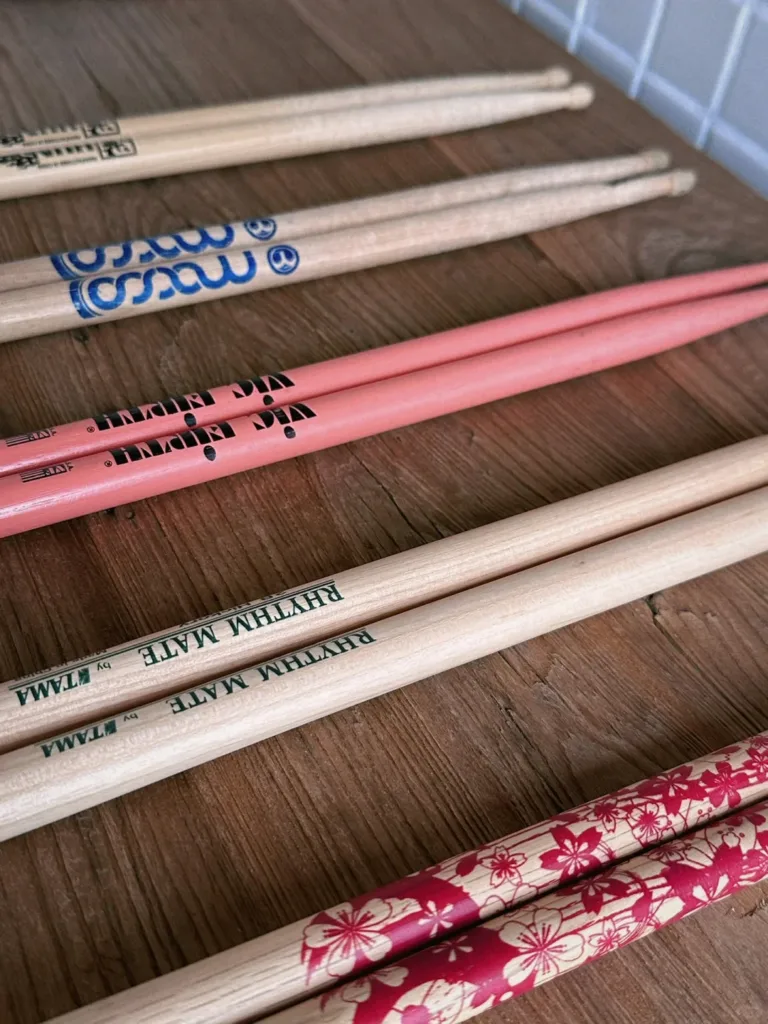
Drum Stick Size and Sound Impact
The size and material of the drum stick also play a significant role in the sound produced.
- Lighter Sticks: Tend to produce a more nuanced and soft sound, perfect for genres where dynamics and expression are crucial.
- Heavy Sticks: Generate more volume and a bolder sound, making them ideal for cutting through the mix in louder genres.
Drum Stick Sizes and Weights: Finding Your Perfect Match
The size and weight of your drumsticks determine your drumming technique, with each aspect having a unique impact on your sound and feel. Let’s break down how these factors work together and what that means for your stick selection.
The Dynamics of Size, Weight, and Technique.
- Size Matters: The diameter of a drum stick affects its grip and how it interacts with the drum head. A thicker stick (like a 2B) is great for heavy hitters, while a thinner stick (like a 7A) is better for precision and speed.
- Weight Wonders: The weight of a stick, influenced by both its size and the wood it’s made of, determines its balance and the effort required to play. Heavier sticks produce louder sounds with less physical exertion, while lighter sticks require more speed and finesse to achieve similar volume levels.
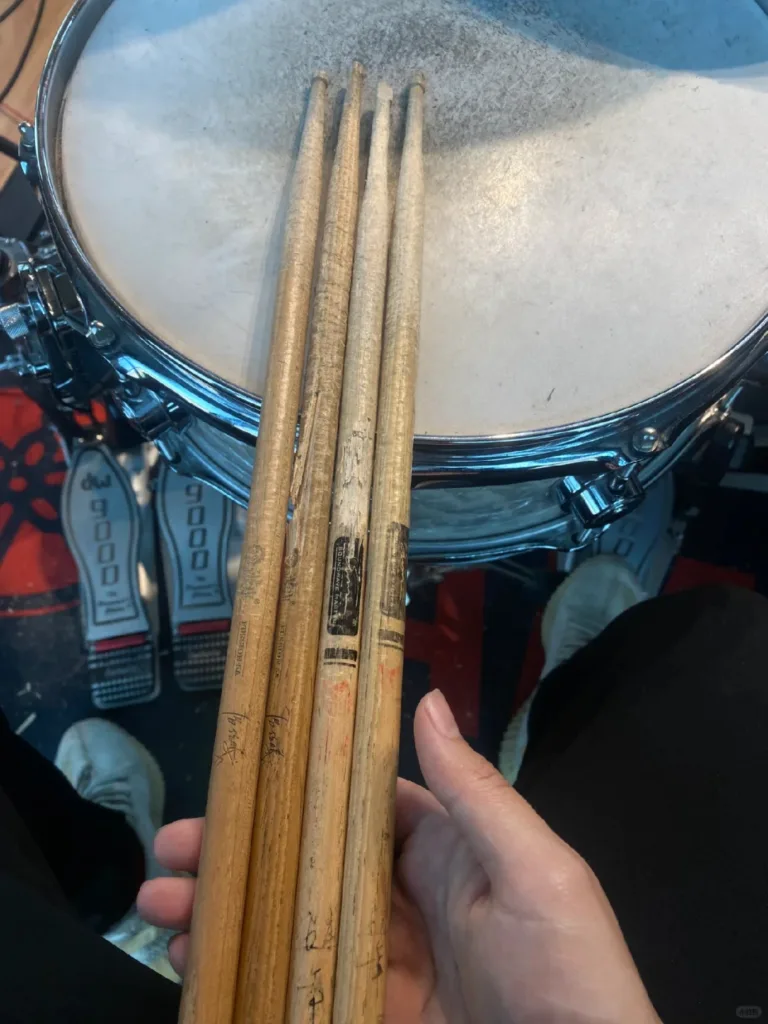
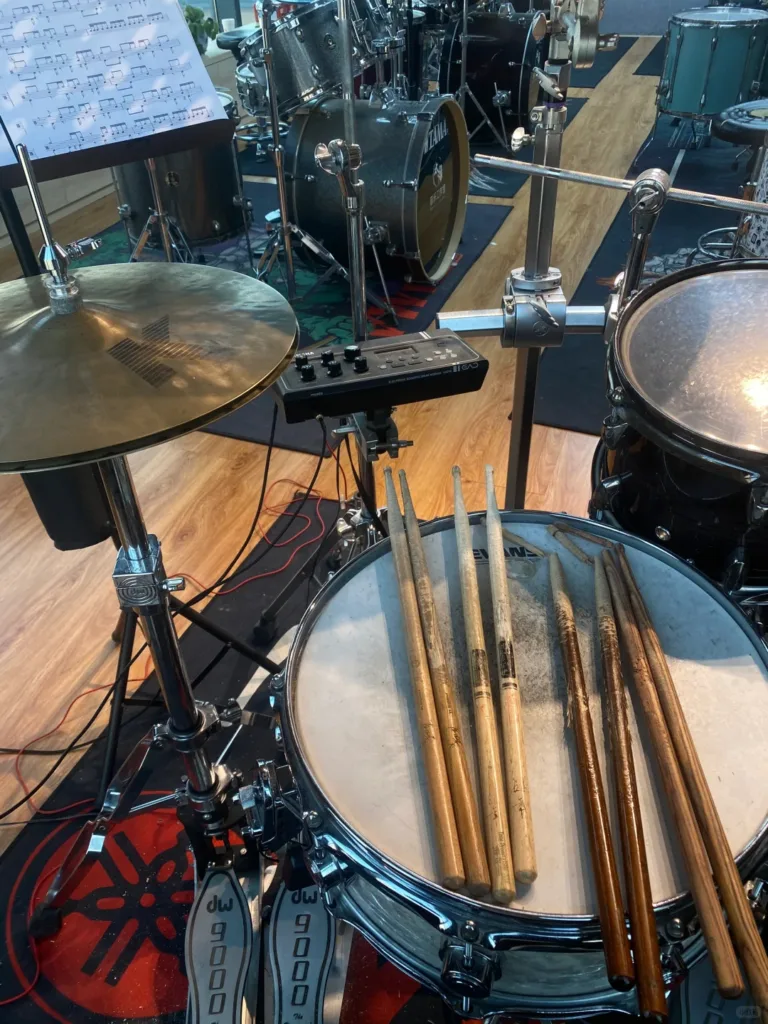
Pros and Cons: Heavier vs. Lighter Sticks
Heavier Sticks (e.g., 2B)
- Pros:
- Greater volume and power, perfect for rock and metal.
- The physical strain of heavy hitting is not as important.
- Cons:
- Playing fast and intricate games can be challenging.
- This may lead to fatigue during extended sessions.
Lighter Sticks (e.g., 7A)
- Pros:
- Enhanced control and speed, ideal for jazz and acoustic genres.
- Easier on the hands, reducing the risk of fatigue.
- Cons:
- Requires more effort to produce loud volumes.
- May break more easily when used for heavy playing.
Case Study: A Tale of Two Drummers
- The Rock Drummer loves the weight and power of 2B sticks and relies on them to deliver thunderous beats that drive the band’s sound. Heavy sticks help you perform without overexertion, which is crucial during energetic live shows.
- The Jazz Aficionado: Opting for the lightness and agility of 7A sticks, this drummer values the ability to execute complex rhythms with ease and precision. The lighter sticks facilitate a wide dynamic range, from the softest rolls to crisp accents.
How drum sticks affect size perception.
A drum stick’s material not only affects its durability but also its size and the sound it makes. Let’s discuss the different types of wood and how they impact your drumming experience.
The essence of Wood Types
- Maple: Known for its lightness, maple sticks are ideal for drummers who prefer a lighter touch and faster playing style. Despite their size, they feel less cumbersome, making intricate rhythms and techniques more manageable.
- Hickory: The middle ground in terms of weight and durability. Hickory sticks offer a balanced feel, suitable for a wide range of playing styles. Their resilience makes them a go-to choice for drummers looking for a reliable stick that matches a variety of sizes.
- Oak: The heavyweight champion of drum stick materials. Oak sticks are dense and durable, providing a solid feel in your hands regardless of their size. Ideal for drummers who demand power and longevity from their sticks.
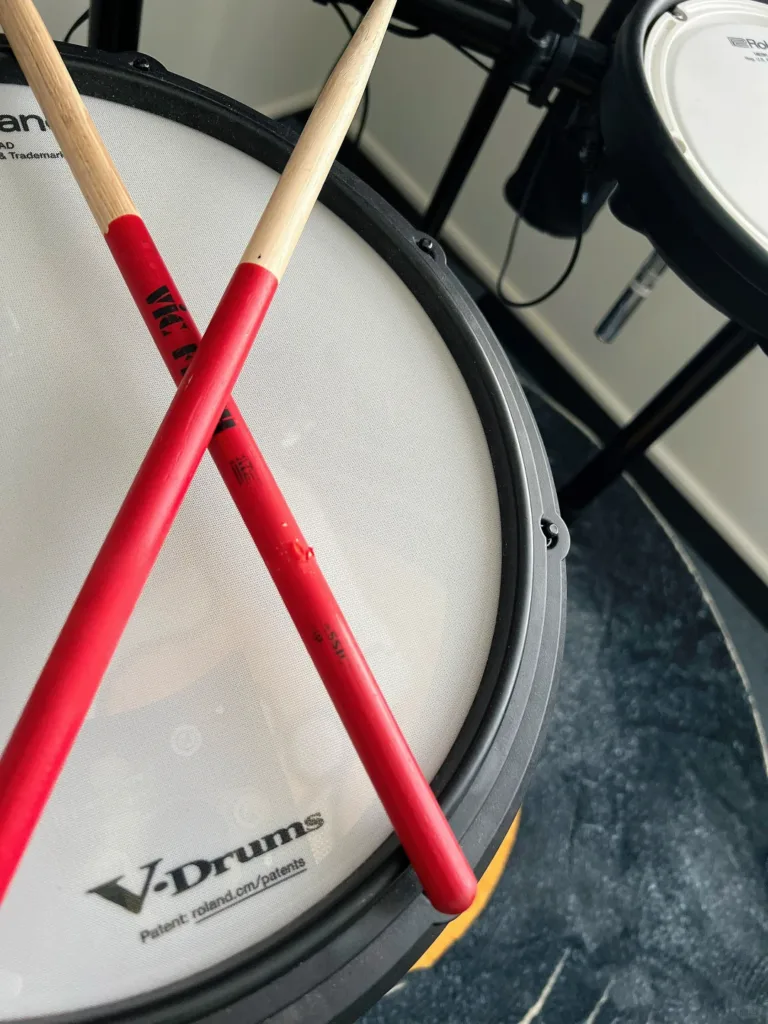
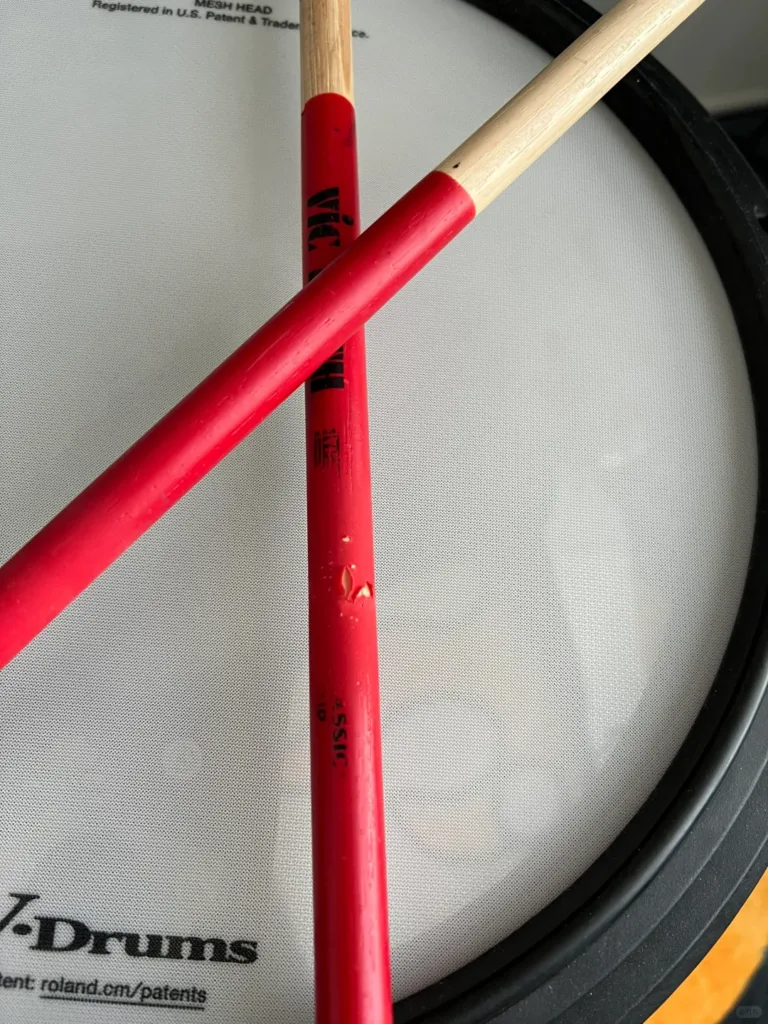
The Impact of Tip Material on Sound
The tip of the drum stick, the point of contact with the drums and cymbals, plays a crucial role in sound production. Choosing between wood and nylon tips can significantly alter the tone and projection of your playing.
- Wood Tips: Produce a warmer, more natural sound, especially on cymbals. The nuances of wood tips complement acoustic settings where the authenticity of sound is paramount.
- Nylon Tips: Offer a brighter, more cutting tone. Their durability and consistency in sound production make them favored for genres that require clarity and projection, such as rock and pop.
Choosing the Right Drum Stick: A Guide for Every Drummer.
Choosing the perfect drum stick size is a crucial decision that affects your playing style, comfort, and the sound you produce. Let’s go through the key factors to consider when making an informed choice.
Factors to Consider
- Hand Size: The size and shape of your hands play a crucial role in determining the ideal stick size. Drummers with larger hands may find thicker sticks like 2B more comfortable and easier to control, while those with smaller hands might prefer the lighter touch of a 7A.
- Music Style: The genre of music you play most often should influence your stick selection. Jazz drummers tend to use lighter sticks for subtlety and speed, while rock and metal drummers may opt for heavier sticks for more power and volume.
- Drum Kit Setup: The type and configuration of drums and cymbals you use can also affect the stick size. A larger kit with more components may benefit from a longer handle for greater reach, whereas a compact setup can be easily navigated with shorter sticks.
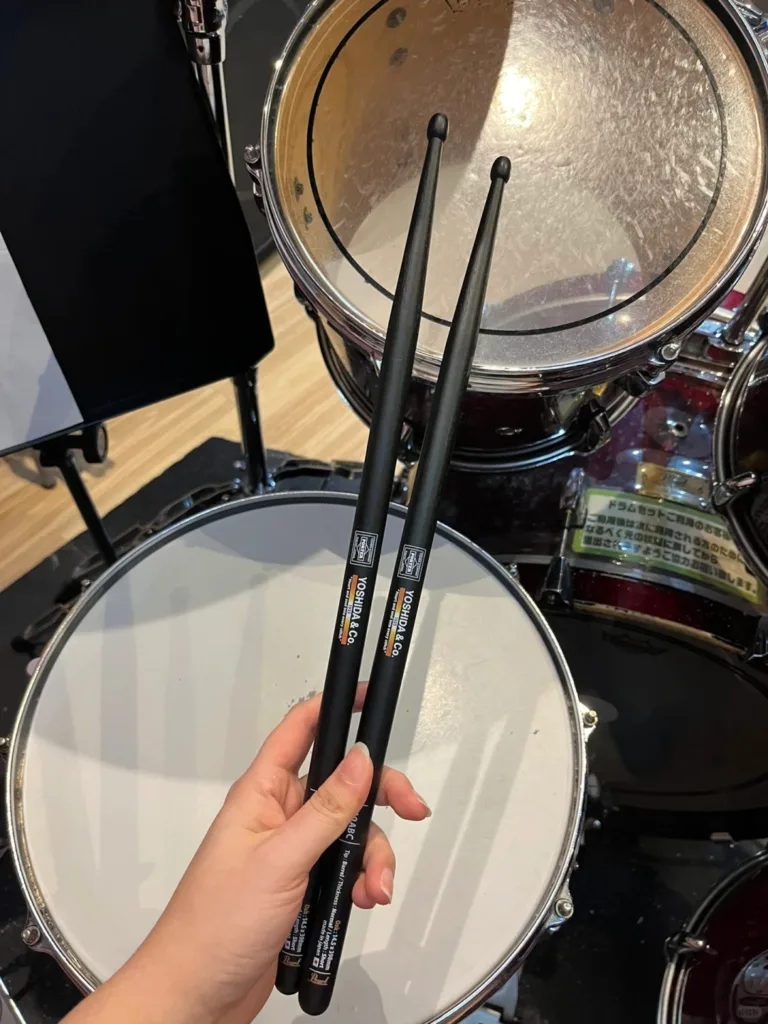
Drum Stick Size for Beginners vs. Advanced Players
- Beginners: Starting with a versatile size like 5A can be beneficial for beginners. It provides a balanced feel that’s not too heavy or light, allowing new drummers to explore various techniques and styles without the stick size limiting their learning curve.
- Advanced Players: Experienced drummers often have a collection of sticks to match different playing situations. They understand that no single stick size is suitable for all situations and choose their sticks based on the specific needs of the music they’re playing at the time.
Conclusion: Embrace the Journey to Find Your Perfect Stick
In the pursuit of the ultimate drumming experience, the size and material of your drumsticks play a crucial role. From the subtle control offered by lighter sticks to the powerful impact of heavier ones, each choice shapes your sound and style. Keep in mind that the ideal stick is not just about comfort; it’s about how it complements your music and enhances your performance.
Let this guide serve as a starting point, not the final word. I encourage you to step out of your comfort zone and try different stick sizes and materials. You might be surprised at how a small change can lead to new musical expressions. So, grab a pair you’ve never tried before and let your playing do the talking. Your perfect stick might just be waiting for you to pick it up.
FAQ:
Choosing between 5A and 5B drumsticks depends on your playing style and preference. If you prefer a balanced stick suitable for various genres, go for 5A. If you’re looking for a guitar with a bit more weight for rock or a heavier playing style, the 5B might be the right choice for you.
The 5A drumstick is widely considered the most versatile and commonly used size among drummers. Its balanced weight and size make it suitable for a wide range of music genres.
Absolutely! The material of your drumsticks, whether wood or nylon, can greatly impact the sound. Wood tips produce a warmer, more natural tone, especially on cymbals, while nylon tips offer a brighter, more defined sound.

